American Chestnuts in Glen Providence Park!

This fall, we were delighted to confirm that we found two healthy young American Chestnut trees in Glen Providence Park! At the beginning of the 20th century, the American Chestnut, Castanea dentata, was a majestic tree dominating our eastern forests. Known as the Sequoia of the east, it was one of our tallest trees. It was the preeminent tree from Maine to Mississippi, and constituted well over 25% of trees in Pennsylvania!
Its nuts and wood were highly valued by European colonists, and doubtless by the Okehocking who lived here before them. According to the American Chestnut Foundation (ACF), it was the single most important food source for a wide variety of wildlife from bears to birds.
Then the Chestnut blight, Cryphonectria parasitica, was discovered in 1904 on imported Asian Chestnut trees in New York City, and it spread across the east- killing an estimated 4 billion trees by 1950. Healthy trees were cut down in a failed attempt to stop the spread of the blight. Saplings still grow from the root sprouts, but they usually die off again when the saplings are large enough to become infected themselves. But there are some larger survivors…
Finding Glen Providence Park’s Chestnuts- by accident!
While volunteering at Tyler Arboretum’s American Chestnut Nursery, which is led by John Wenderoth, I learned to differentiate American, Chinese and Japanese Chestnut leaves. With John, we sent leaf samples to the ACF for identification and confirmed blighted American Chestnut saplings in Long Point Wildlife Sanctuary in Rose Valley, and a Japanese Chestnut on the Sledding Hill in Glen Providence Park!*
Then in Glen Providence Park last October, I was photographing some bright yellow mushrooms I had noticed on the eastern hill, when I looked up and marveled to see what looked like American Chestnut leaves! There are two chestnut trees measuring about 15′ and 25′ tall. This fall, Sara Fitzsimmons of the Pennsylvania Chapter of the ACF confirmed by microscope analysis that the leaves are American! We also found chestnut burrs (the spiky nut casings) on the western hill, but have not yet located their tree…
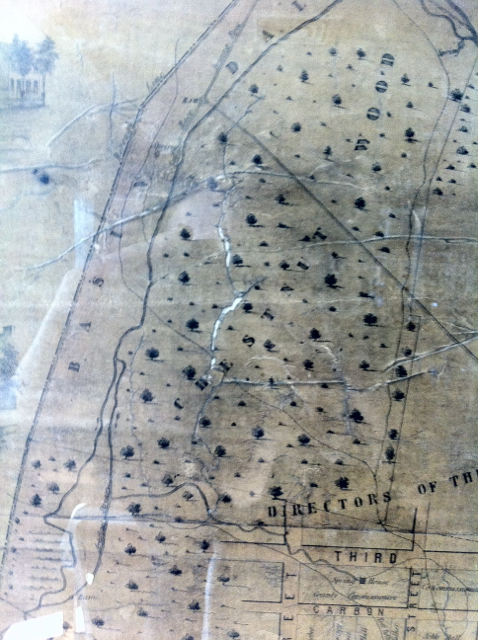
1855 Map of Media by Thomas Hughes showing “Chestnut Wood” by the current Broomall’s Lake – from Media Historic Archives
History of Chestnuts in Scroggie Valley
It turns out it is not so surprising to find these chestnuts, as we uncovered historical documentation of American Chestnuts in Scroggie Valley, most of which would become Glen Providence Park.
T. Chalkley Palmer’s detailed 1889 description of Scroggie Valley mentions chestnuts: “The northwest wall is… nearly devoid of trees. The southeast wall is wooded continuously with oaks and chestnuts.” And he described the singing of the Hermit Thrush “…of a morning, from the top of the chestnut tree on the hill.”
Even earlier, an 1855 map of Media labels as “Chestnut Wood” the area to the east of Broomall’s Run, near what is now Broomall’s Lake. Some of those may have been submerged when dam was built in 1883, and according to a 1905 article about the Media Grackle Roost near Broomall’s Lake, the rest were logged: “On the eastern side of the lake and stream the old “Camp Meeting Woods,” principally chestnut, was wrought up for commercial purposes”.
By 1912 the blight had hit our area: according to a Chester Times report of a Chestnut Blight talk at the Delaware County Institute of Science, the blight was “generally spread” in Eastern Pennsylvania, but had not yet spread to the Western part of the state.
In 1915, the Chester Times lamented the near-decimation of the chestnuts and their beautiful woods: “Many of the hills in and near Media, which have in past years been noted for their beauty because of the forests which crowned them, will, before the end of the present summer, stand bare except for the disfiguring stumps, mute reminders of the old conditions.”
Amazingly, as recent as 1935 there is documentation of chestnuts in the park- the Chester Times described chestnut saplings on George Butler’s estate, which would soon be donated for Glen Providence Park: “A close observer of nature finds many young chestnut trees coming up on the estate of Edward B. Creighton and Mr. Butler.” The article recalls, “In days gone by… those having nut trees on their estates and farms would have house parties and their guests would carry back to their homes baskets filled with nuts…”
While over time most of those saplings would have succumbed to the blight, we now know that at least two have survived! We provided these historical records to the ACF, and we will continue to monitor these two American Chestnuts for them- and look for more! We also hope to plant more American Chestnuts in Glen Providence Park, with the help of the ACF’s research…
Restoration efforts:
There have been a variety of efforts to save the American Chestnut since the blight was discovered, from fungicides to irradiation. As a result of decades of “backcrossing” Chinese and American Chestnuts by the ACF, there is now a hybrid “restoration chestnut” with 94% American genes, but with just enough Chinese traits to provide blight resistance. Tyler Arboretum’s American Chestnut Nursery grows trees to provide nuts to help preserve a genetic stock of pure American Chestnuts.
On a personal note, I learned that my grandfather worked on restoring the American Chestnut for decades in his retirement, which I didn’t know until after I became interested in American Chestnut restoration and started volunteering! His work is cited in Susan Freinkel’s 2007 book “American Chestnut- The Life, Death, and Rebirth of a Perfect Tree.”
Keep your eyes out in the park (and in your family records!), you really never know what you will find!
* I had actually been tipped off about there being a chestnut tree on the Sledding Hill when HACC Biology Professor Geremea Fioravanti of the Delaware County Institute of Science posted a photo of a chestnut burr on our facebook page!
For more information:
– Visit the American Chestnut Foundation and PA Chapter of the American Chestnut Foundation websites
– Read “The chestnut resurrection,” Nature, October 4, 2012
– Volunteer at Tyler Arboretum’s American Chestnut Nursery!
Surviving American Chestnuts & restoration efforts in Pennsylvania include:
– Natural Lands Trust’s Mariton Preserve in Easton, PA
– Jenkins Arboretum in Devon
Additional Sources:
– “Scroggie,” T. Chalkley Palmer, The Student, Germantown, PA, December 1889 & January 1890
– “The Media Grackle Roost,” Samuel Omensetter, Cassinia, Proceedings of the Delaware Valley Ornithological Club, No. IX, Philadelphia, PA, 1905
– “American Chestnut – The Life, Death and Rebirth of a Perfect Tree,” Susan Freinkel, University of California Press, 2007
Chester Times articles:
– No Known Cure for Chestnut Blight – August 13, 1912
– Passing of the Woods – May 1, 1915
– Relics of Chestnut Blight – Gaunt Skeletons Rear Themselves in Every Wood Tract – August 10, 1916
– Unique Arboretum on County Estate – June 14, 1935
You can click on any photo for a closer look, and scroll through the photos below.
- The yellow mushrooms that led us to the American Chestnuts
- American Chestnut leaves in Glen Providence Park
- 1855 Map of Media by Thomas Hughes showing “Chestnut Wood” by the current Broomall’s Lake – from Media Historic Archives
- American Chestnuts in North Carolina in 1910 – courtesy of the Forest History Society, Durham, NC
- 1935 article from Chester Times citing American Chestnut saplings in future Glen Providence Park
- Blight on American Chestnut at Longpoint Wildlife Sanctuary in Rose Valley
- Leaves of American Chestnut (left & top), American Beech (right) & Japanese Chestnut (bottom) from Glen Providence Park
- Japanese Chestnut branch with burrs in Glen Providence Park- the (very prickly!) burrs contain nuts

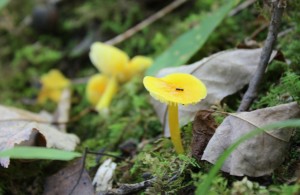


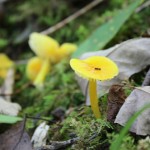
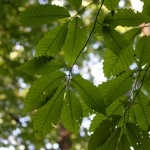
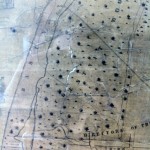
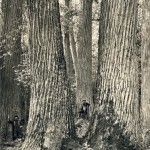
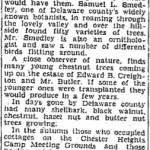
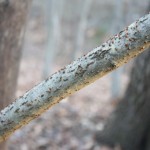
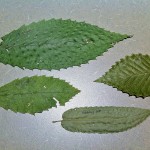
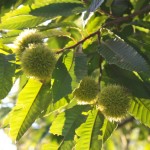






Hello Friends of Glen Providence Park- Teacher Chris Howells here! I am so happy to read of your progress with the park! The chestnut trees are such an exciting development. I hope that students at Media Providence Friends School will have a chance to study the chestnut at length- it is exciting that there have been so many developments in the restoration efforts. Perhaps the Glen Providence trees may have valuable genes that could be a part of the breeding program. This is why preserving natural spaces is so important! A unique and special tree could easily be lost forever without careful eyes on the job! I feel so happy to know that my students will know this fact from a very experiential standpoint. Thanks for keeping me on your e-list. I will continue to follow your progress from Asheville North Carolina, where I will be moving very soon. There is a Forest History museum near where we are moving and I would encourage any of my former students and their families to come to Asheville and visit us and enjoy the national forests with us! Blessings to All! Teacher Chris and Family
Hi Teacher Chris,
It is lovely to hear from you! The Forest Museum sounds wonderful- and Asheville is where the American Chestnut Foundation is based! Thank you for continuing to follow us, and for inspiring students to deepen their care of the natural world. The best of luck in North Carolina!
Stephanie
Fascinating story about the chestnut trees.
Can you tell me the exact title of the 1855 map by Thomas Hughes? I am compiling a list of all known maps by the four Hughes brothers(Thomas, Michael, James and my great-great grandfather Matthew). They were Irish immigrants and surveyors who worked together in the 1850s through the 1870s producing these maps of communities in NJ, eastern PA, and southern NY. The brothers worked out of Philadelphia and then Trenton.
Thanks so much.
C. Hughes
How interesting about your great-great grandfather! Part of the map is deteriorated, but this is what I can read:
“Map of Media
The Seat of Justice [of?]
Delaware County
Pennsylvania
Surveyed, [–wn] and published by
Thos. Hughes, C.E.
1855
Lith. of Friend & [—–] Walnut St., Philad.”
There are two framed maps on display in Media- one at the Media Historic Archives at the library, and the other at Media Borough Council Chambers at Borough Hall. Good luck with your research!
Stephanie
Stephanie:
So Sorry not to have checked back sooner, but I really appreciate your taking the time to do this. I worked for non-profits for thirty years, so I know you likely had a lot on your plate and that this wasn’t exactly your top priority. So far, this is the earliest known map produced by my ancestors!
Thank you again.
Carolyn
Hi Carolyn,
You are quite welcome- it is a wonderful map! I love the drawings on it, and it was very useful in my historical research of the park. That is exciting that it is the earliest so far.
Stephanie
Great article- sorry I missed it last year:) Any thought into trying to plant some American Chestnuts in the park again?
Rich
Thank you, Rich! We have had preliminary discussions with the American Chestnut Foundation about planting “restoration” American Chestnut hybrids in the park, but there are no specific plans yet. Thank you for reminding me- it could work for our 2014 planting location!
Thank you for this very interesting article.
I often walk over the 3rd street dam and have noticed several saplings of ca 15 ft height at the top of the hill (on the Upper Providence side) just off the road which appeared to me to be American Chestnut, but badly affected by the blight. one recently expired and was then knocked over in late fall 2014. A rather large Chestnut was felled in the park near the Kirk lane entrance in 2013 – the freshly sawn wood gave off that characteristic fragrance which some have likened to vomit.
The Chestnut is a very interesting tree. That sprouts have continued to come up vigorously from the underground stump network more than a century after the blight first hit is quite interesting. In my yard on Azalea Lane, when a 15 ft. sapling expired from blight last year, perhaps two dozen sprouts appeared.
Hi Jonathan,
Thank you for pointing out the chestnut saplings by the Kirk Lane entrance – I will definitely check those out when the leaves have emerged, and I will submit them to the American Chestnut Foundation database! I am sad to hear that one of the cut trees may have been a chestnut – do you know whether it was alive or dead at the time? Would you be able to identify which trunk it is now? I am interested to hear that you have American Chestnut saplings in your yard, too! This is excellent incentive to do further searches for chestnuts in the park.
Thank you,
Stephanie Gaboriault
Hi, Stephanie,
— I am pretty sure that the chestnut cut down was almost completely dead. there were large bark sheds and some major limbs of the tree were dead. still, some part of it might have been barely alive cause the cut wood was moist still.
the stump is still there. As one climbs over the chain at the entry, it is the first stump over on the left, maybe 15 inches in diameter, twenty feet or so into the park, cut at an angle, not parallel to the ground.
From the shape of the smaller branches and bark, I believe there are a couple other trees in that area of the park that might be chestnut
– Jonathan
Thank you, Jonathan – I will definitely be checking these out! And I will scan my old photos of that entrance to see if any show the chestnut that was cut.
Stephanie, I really admire the care, time, and research you put into your involvement with the Park. This is a fascinating article and I love seeing the old documents you have unearthed.
Hi Chara, Thank you for your kind words, and for taking the time to write them. I am glad you enjoyed the article! Stephanie